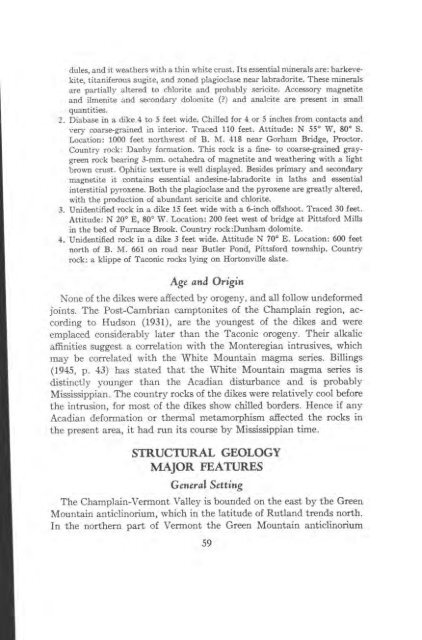STRATIGRAPHY AND STRUCTURE CASTLETON AREA VERMONT
STRATIGRAPHY AND STRUCTURE CASTLETON AREA VERMONT
STRATIGRAPHY AND STRUCTURE CASTLETON AREA VERMONT
You also want an ePaper? Increase the reach of your titles
YUMPU automatically turns print PDFs into web optimized ePapers that Google loves.
dules, and it weathers with a thin white crust. Its essential minerals are: barkevekite,<br />
titaniferous augite, and zoned plagioclase near labradorite. These minerals<br />
are partially altered to chlorite and probably sericite. Accessory magnetite<br />
and ilmenite and secondary dolomite (?) and analcite are present in small<br />
quantities.<br />
2. Diabase in a dike 4 to 5 feet wide. Chilled for 4 or 5 inches from contacts and<br />
very coarse-grained in interior. Traced 110 feet. Attitude: N 55° W, 80° S.<br />
Location: 1000 feet northwest of B. M. 418 near Gorham Bridge, Proctor.<br />
Country rock: Danby formation. This rock is a fine- to coarse-grained graygreen<br />
rock bearing 3-mm. octahedra of magnetite and weathering with a light<br />
brown crust. Ophitic texture is well displayed. Besides primary and secondary<br />
magnetite it contains essential andesine-labradorite in laths and essential<br />
interstitial pyroxene. Both the plagioclase and the pyroxene are greatly altered,<br />
with the production of abundant sericite and chlorite.<br />
3. Unidentified rock in a dike 15 feet wide with a 6-inch offshoot. Traced 30 feet.<br />
Attitude: N 20 1 E, 80° W. Location: 200 feet west of bridge at Pittsford Mills<br />
in the bed of Furnace Brook. Country rock:Dunham dolomite.<br />
4. Unidentified rock in a dike 3 feet wide. Attitude N 70 ° E. Location: 600 feet<br />
north of B. M. 661 on road near Butler Pond, Pittsford township. Country<br />
rock: a klippe of Taconic rocks lying on Hortonville slate.<br />
Age and Origin<br />
None of the dikes were affected by orogeny, and all follow undeforrned<br />
joints. The Post-Cambrian camptonites of the Champlain region, according<br />
to Hudson (1931), are the youngest of the dikes and were<br />
emplaced considerably later than the Taconic orogeny. Their alkalic<br />
affinities suggest a correlation with the Monteregian intrusives, which<br />
may be correlated with the White Mountain magma series. Billings<br />
(1945, p. 43) has stated that the White Mountain magma series is<br />
distinctly younger than the Acadian disturbance and is probably<br />
Mississippian. The country rocks of the dikes were relatively cool before<br />
the intrusion, for most of the dikes show chilled borders. Hence if any<br />
Acadian deformation or thermal metamorphism affected the rocks in<br />
the present area, it had run its course by Mississippian time.<br />
STRUCTURAL GEOLOGY<br />
MAJOR FEATURES<br />
Genera! Setting<br />
The Champlain-Vermont Valley is bounded on the east by the Green<br />
Mountain anticlinorium, which in the latitude of Rutland trends north.<br />
In the northern part of Vermont the Green Mountain anticlinorium<br />
59













